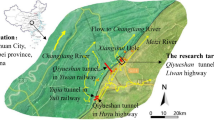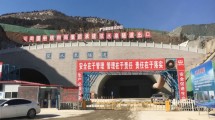Abstract
This paper is based on the construction project of Wuhan Metro line 6 from Qianjincun Station to Mayinglu Station. In view of the geological condition of overlying sand and underlying limestone, by using FLAC3D5.0 software and considering the fluid–solid coupling effect, the influences of distance between karst cave roof and bedrock surface d, cave diameter D, width w and filling degree ω on the deformation and force of subway tunnel segment after excavation are analyzed. The results show that: (1) The vertical settlements and the axial forces at vault and arch bottom are negatively correlated with d and ω. The axial force at right hance and bending moments at each control point are positively correlated with d and ω. (2) With the increase of D and w, the vertical displacements and axial forces at vault and arch bottom tend to increase. The axial force at right hance and bending moments at each control point have a negative correlation with D and w. (3) Compared with other control points, the axial force and bending moment of arch bottom are the largest and the bending moment of right hance is the smallest. (4) The greater d, the smaller the amplitude of variation of the displacements and internal forces of the segment. The greater D, w and ω, the greater the amplitude of variation of the displacements and internal forces of the segment. The research results can provide guidance for similar engineering.
















Similar content being viewed by others
References
Day MJ (2004) Karstic problems in the construction of Milwaukee’s deep tunnels. Environ Geol 45(6):859–863
Do NA, Dias D, Oreste P (2016) 3D numerical investigation of mechanized twin tunnels in soft ground—influence of lagging distance between two tunnel faces. Eng Struct 109:117–125
Guo L, Fu HL, Ouyang GJ et al (2010) Numerical simulation of pit excavation of a subaqueous tunnel considering fluid–solid coupling effect. Mod Tunn Technol 47(04):12–19
Gutierrez F, Parise M, De Waele J et al (2014) A review on natural and human-induced geohazards and impacts in karst. Earth Sci Rev 138:61–88
Huang F, Zhao LH, Ling TH et al (2017) Rock mass collapse mechanism of concealed karst cave beneath deep tunnel. Int J Rock Mech Min Sci 91:133–138
Kang J (2017) Study on the influence of filling karst cave on ultimate bearing capacity of metro tunnel foundation. Hunan Commun Sci Technol 43(01):161–165
Lee IM, Nam SW (2004) Effect of tunnel advance rate on seepage forces acting on the underwater tunnel face. Tunn Undergr Space Technol 19(3):273–281
Lei JS (2014a) Foundation stability and filling technology research on hidden karst in Guangzhou Metro. Dissertation, Central South University, Changsha
Lei MM (2014b) Study on surrounding rock stability of tunnel in karst zone base on the fluid–soild couple. Dissertation, Chongqing Jiaotong University, Chongqing
Li CL, Miao LC (2016) Determination of the range of shield tunneling-induced soil disturbance. Rock Soil Mech 37(03):759–766
Li DY, Li XB, Zhang W et al (2007) Stability analysis of surrounding rock of multi-arch tunnel based on coupled fluid–solid theorem. Chin J Rock Mech Eng 26(05):1056–1064
Li PN, Liu J, Su F (2013) Numerical analysis on effect of karst cave on stability in metro tunnel excavation. Subgrade Eng 04:76–81
Li YY, Zhang SC, Zhang X (2018) Classification and fractal characteristics of coal rock fragments under uniaxial cyclic loading conditions. Arab J Geosci 11(9):201
Liu XR (2016) Study on Deformation characteristics of metro tunnel structure in the soil of karst combined with silt stratum. Dissertation, Guangzhou University, Guangzhou
Melis M, Medina L, Rodríguez JM (2002) Prediction and analysis of subsidence induced by shield tunnelling in the Madrid Metro extension. Can Geotech J 39(6):1273–1287
Ministry of Housing and Urban-Rural Development (2013) Code for monitoring measurement of urban rail transit engineering vol GB50911–2013. China Architecture & Building Press, Beijing
Mooney MA, Grasmick J, Kenneally B et al (2016) The role of slurry TBM parameters on ground deformation: field results and computational modelling. Tunn Undergr Space Technol 57:257–264
Ning YH (2013) Study on the influence of the karst cave to the foundation’s stability and bearing capacity in shield tunnelling. Dissertation, Central South University, Changsha
Shan RL, Zhang XN, Lu M (2018) Numerical application of safe thickness between a tunnel and surrounding concealed caves. Geotech Geol Eng 36(1):95–104
Shao Y, Yan CH, Xu BT et al (2012) Analysis on the influence of small caves on stability of underground tunnel. Geol Rev 58(03):519–525
Shi G, Yang X, Yu H et al (2019) Acoustic emission characteristics of creep fracture evolution in double-fracture fine sandstone under uniaxial compression. Eng Fract Mech 210:13–28
Su W (2009) Study on influence of karst cave on mechanical properties and surrounding rock pressure of metro tunnel. Dissertation, Central South University, Changsha
Su F, Zheng WB (2013) Numerical simulation for influence of karst cave on surrounding rock stability of subway tunnel. Yangtze River 44(03):25–29
Tao Z, Wang Y, Zhu C et al (2019) Mechanical evolution of constant resistance and large deformation anchor cables and their application in landslide monitoring. Bull Eng Geol Environ 2019:1–17
Waltham AC, Swift GM (2004) Bearing capacity of rock over mined cavities in Nottingham. Eng Geol 75(1):15–31
Wang H, Sun XD (2015) Simulation of fluid–solid interaction effect in rich water tunnel based on FLAC-3D. J Liaoning Tech Univ (Nat Sci) 34(04):468–473
Wang W, Gao SM, Liu LF et al (2019) Analysis on the safe distance between shield tunnel through sand stratum and underlying karst cave. Geosyst Eng 22(2):81–90
White WB (2002) Karst hydrology: recent developments and open questions. Eng Geol 65(2–3):85–105
Xie XY, Tang GJ (2018) Effects of curved shield tunnelling adjacent to existing power tunnel. Eur J Environ Civil Eng 22(s1):164–178
Yi JM (2011) Numerical Simulation of the stability of subway tunnel in karst regions. Dissertation, South China University of Technology, Guangzhou
Yu LY, Li SC, Xu BS et al (2011) Study of solid–fluid coupling model test and numerical analysis of underwater tunnels. Chin J Rock Mech Eng 30(07):1467–1474
Zhang DR (2014) Study on the lower bound analysis method to obtain bearing capacity of subway tunnel in karst areas. Dissertation, Central South University, Changsha
Zhang SC, Li YY, Shen BT et al (2019) Effective evaluation of pressure relief drilling for reducing rock bursts and its application in underground coal mines. Int J Rock Mech Min Sci 114:7–16
Zhao HG (2012) Research on the influence of caves on the stability of new subway tunnels and construction technology. Constr Technol 41(15):88–91
Zhu C, Tao ZG, Yang S et al (2018) V shaped gully method for controlling rockfall on high-steep slopes in China. Bull Eng Geol Environ 2018:1–17
Author information
Authors and Affiliations
Corresponding author
Additional information
Publisher's Note
Springer Nature remains neutral with regard to jurisdictional claims in published maps and institutional affiliations.
Rights and permissions
About this article
Cite this article
Wang, W., Gao, S., Min, Y. et al. Three-Dimensional Fluid–Solid Coupling Numerical Simulation of Effects of Underlying Karst Cave on Shield Tunnel Through Sand Stratum. Geotech Geol Eng 37, 4825–4836 (2019). https://doi.org/10.1007/s10706-019-00941-x
Received:
Accepted:
Published:
Issue Date:
DOI: https://doi.org/10.1007/s10706-019-00941-x




